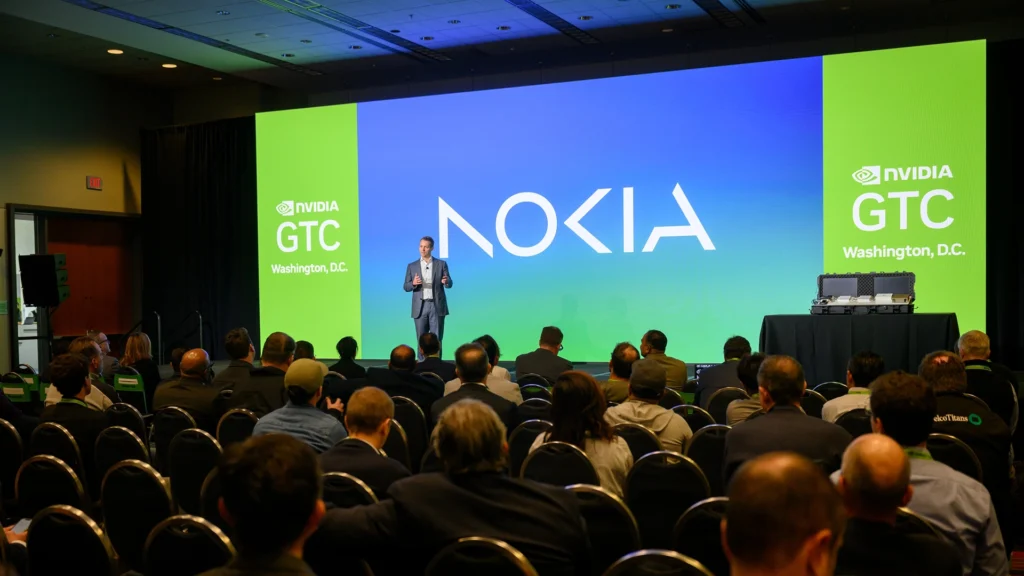NVIDIA will invest $1.0 billion in Nokia via a directed share issue at $6.01/share for ~166.4 million new shares (a ~2.9% stake), alongside a strategic partnership to build AI-native wireless networks.
The collaboration aims to add NVIDIA‑powered AI‑RAN products to Nokia’s RAN portfolio, catalyzing the transition from today’s 5G to 5G‑Advanced and 6G. Nokia’s stock spiked more than 20% on the announcement as investors re‑rated the Finnish vendor’s AI‑data‑center and next‑gen networking story.
Highlights
- $1B equity + product partnership: NVIDIA takes ~2.9% of Nokia through a directed share issue (≈166.4M shares at $6.01), paired with a multi year AI RAN roadmap.
- ARC Pro platform named: Launch of NVIDIA Aerial RAN Computer Pro (ARC Pro) — a 6G ready accelerated platform that fuses connectivity, compute and sensing for AI native RAN. First operator + timeline: T Mobile US to collaborate with Nokia and NVIDIA; field evaluations begin in 2026 as part of its 6G development process.
- Ecosystem hardware: Dell Technologies PowerEdge servers power Nokia’s AI RAN solution; no touch software and low touch silicon upgrades flagged.
- Market sizing: AI RAN cited as a $200B+ cumulative opportunity by 2030, per Omdia.
- AI networking add-ons: Cooperation spans NVIDIA Spectrum X Ethernet with Nokia SR Linux, plus exploration of Nokia optical tech in future NVIDIA AI infrastructure.
What Was Announced (and Why It Matters)
Announced at GTC Washington, D.C. (Oct 28, 2025), Nokia will issue new shares to enable NVIDIA’s $1B investment (subject to closing conditions) and the companies will commercialize AI‑RAN: RAN functions (scheduling, beamforming, interference management) enhanced by GPU‑accelerated machine learning.
NVIDIA also unveiled Aerial RAN Computer Pro (ARC‑Pro), a 6G‑ready reference platform designed to let operators move from 5G‑Advanced to 6G largely via software upgrades.
The release named T‑Mobile US as the first operator collaborator, with field trials slated for 2026, and highlighted Dell PowerEdge servers as the compute backbone of Nokia’s AI‑RAN solution.
Nokia will accelerate its RAN software on CUDA and embed ARC‑Pro at the heart of its new AI‑RAN offerings; its anyRAN approach and modular AirScale baseband are meant to smooth deployments across Cloud RAN and purpose-built RAN. The partners also flagged cooperation in AI networking (NVIDIA Spectrum‑X Ethernet with Nokia SR Linux) and potential use of Nokia optics in future NVIDIA AI infrastructure.
Board takeaway: This is not just a financial stake, it’s a product and platform bet that pulls the wireless access network into the AI compute economy.
The Strategic Logic
- For NVIDIA: Extend the AI platform from cloud into the network fabric. AI‑RAN and edge inference are logical adjacencies for Blackwell‑class systems, networking, and software (CUDA, TensorRT). It also strengthens NVIDIA’s ecosystem moat across data center, edge, and device.
- For Nokia: Add AI acceleration and multi‑model ML into its RAN stack, positioning for 5G‑Advanced and 6G while diversifying compute beyond entrenched silicon paths. Proceeds fund trusted connectivity and AI‑era product acceleration.
Why AI‑RAN Is a Big Deal (Industry Context)
Traditional RANs rely on fixed‑function silicon and heuristics. AI‑RAN uses learning systems to optimize spectrum use, energy draw, and quality of experience in real time — crucial as traffic explodes from AI agents, video, and IoT. For carriers, that promises:
- Higher spectral efficiency (more bits per hertz through adaptive beamforming and interference prediction).
- Lower energy per bit via dynamic sleep/wake and power control.
- Programmable services at the edge (private 5G, industrial AI, low‑latency apps).
It’s also a step toward open, software-defined networks where carriers can mix vendors and upgrade capabilities through software.
Deal Terms and Structure
- Size & stake: $1.0B for ~2.90% of Nokia; ~166.4M new shares at $6.01/share via directed issuance.
- Use of proceeds: Accelerate Nokia’s AI‑RAN roadmap and broader AI connectivity strategy.
- Commercial track: Co‑development of NVIDIA‑powered AI‑RAN products integrated into Nokia’s RAN portfolio; go‑to‑market with communication service providers (CSPs).
Market Reaction & Competitive Map
- Nokia re‑rating: Stock jumped over 20%, reaching highs not seen since 2016, reflecting confidence in AI‑edge growth.
- Peers on watch: Ericsson, Huawei, ZTE, and Samsung must answer on AI‑RAN roadmaps and telco‑edge compute strategies.
- Silicon dynamics: This could shift share among Marvell, Intel, and specialized RAN silicon if GPU‑accelerated paths gain traction.
What This Means for Carriers (CSPs) and Enterprises
- RAN modernization: Pilots for AI scheduling, beamforming, and anomaly detection at dense urban sites and private networks.
- Edge buildouts: More micro‑data‑centers at aggregation points; attention to power, cooling, and backhaul.
- OPEX levers: Energy savings and automation could offset capex, especially where power costs are high.
- Enterprise 5G: Private 5G campuses gain computer‑vision and industrial AI use‑cases with better reliability/latency.
Risks & What to Watch
- Power and thermal budgets at edge sites; liquid/advanced cooling may be needed in hot climates.
- Standards & interoperability: Alignment with 3GPP (Release 18/19) and O‑RAN interfaces to avoid lock‑in.
- Execution: Shipping carrier‑grade software with five‑nine reliability is hard; lab KPIs must match field KPIs.
- Geopolitics/export controls: Supply chain and market‑access constraints could shape where AI‑RAN deploys first.



